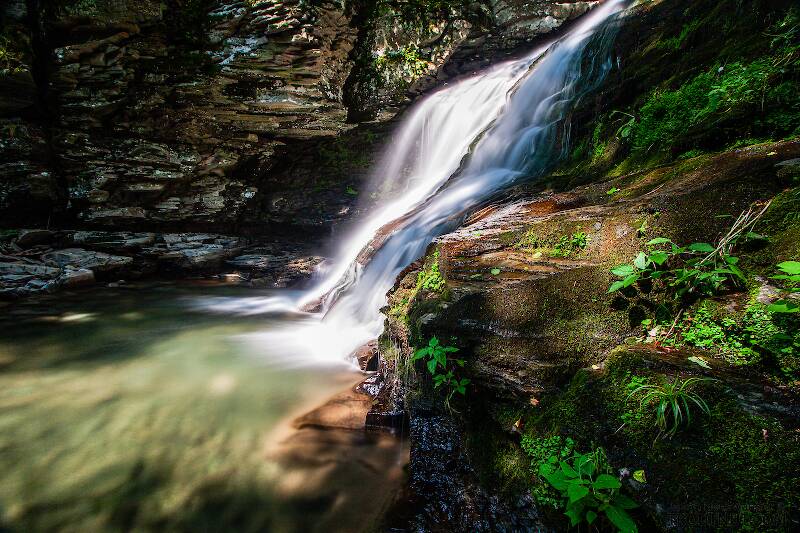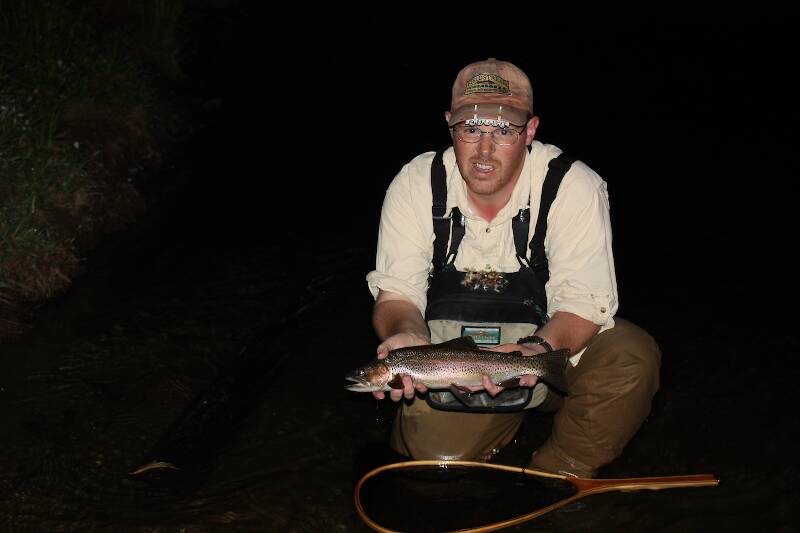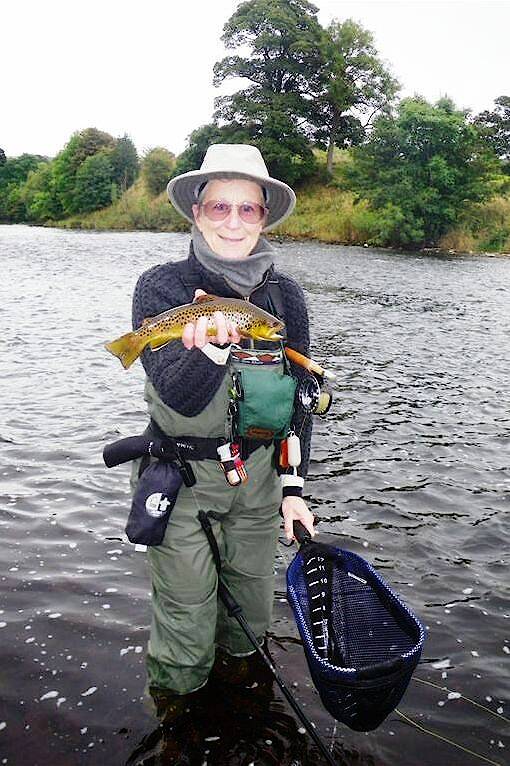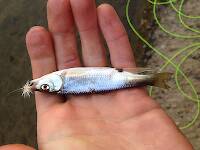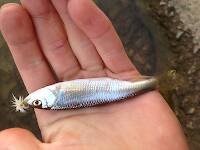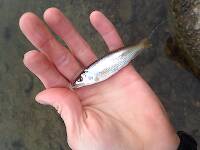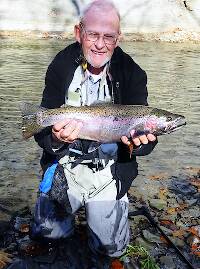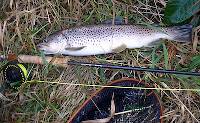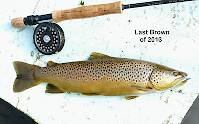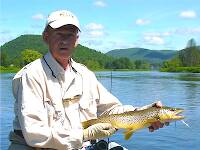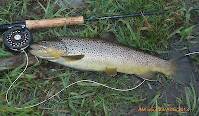
Salmonflies
Pteronarcys californica
The giant Salmonflies of the Western mountains are legendary for their proclivity to elicit consistent dry-fly action and ferocious strikes.
Featured on the forum

This one pretty clearly keys to Kogotus, but it also looks fairly different from specimens I caught in the same creek about a month later in the year. With only one species of the genus known in Washington, I'm not sure about the answer to this ID.

Troutnut is a project started in 2003 by salmonid ecologist Jason "Troutnut" Neuswanger to help anglers and
fly tyers unabashedly embrace the entomological side of the sport. Learn more about Troutnut or
support the project for an enhanced experience here.
Martinlf on Sep 16, 2007September 16th, 2007, 4:39 am EDT
As those who know me well can attest, I've been fishing very little lately due to a work overload, but I have reserved an hour or so per day to unwind, casting in the yard. I finally found an ideal spot to observe my backcast and using Lefty Kreh's modern casting method, have finally achieved fairly consistent backcasts. What helped was to find a spot in front of my house (a ranch) and backcast up towards the roof. The house cuts off enough of the sky that glare isn't a problem, but I can see the loop in the sky up over the roof well enough to see what is going on. It has helped a lot to have Bob Clouser's Flyshop nearby. After spending about an hour diagnosing my casting problems, and teaching me how to control loops, Bob has very generously given me helpful tips several times when I came back for specific questions that have arisen. It's taken daily practice to work out most of the major kinks, and I know that only with continuing daily practice will I get where I want to be, but I'm at last confident that I am going to move ahead with my casting. I'm posting this up to encourage anyone else who is spending some time lawn casting and to suggest one approach to tightening those loops. I'd be glad to hear of others' experiences.
"He spread them a yard and a half. 'And every one that got away is this big.'"
--Fred Chappell
--Fred Chappell
Shawnny3 on Sep 16, 2007September 16th, 2007, 10:51 am EDT
Thanks, Louis. I've known for a long time that my casting was a mess, but I've never really practiced casting. Turning almost exclusively to nymphing in the past 5 years hasn't done much for it, either - I know it's uglier than ever. I hope your post inspires me to improve enough that I actually get off my bum and do something about it.
-Shawn
P.S. And for the record, I don't think your casting was that ugly to begin with. I thought it quite impressive, actually, which is why your attention to it might just shame me into addressing my own foibles.
-Shawn
P.S. And for the record, I don't think your casting was that ugly to begin with. I thought it quite impressive, actually, which is why your attention to it might just shame me into addressing my own foibles.
Jewelry-Quality Artistic Salmon Flies, by Shawn Davis
www.davisflydesigns.com
www.davisflydesigns.com
Martinlf on Sep 17, 2007September 17th, 2007, 10:18 am EDT
Shawn, thanks for your kind words and for silencing those darn crickets again. I've managed to get by dry fly fishing under calm situations with an adequate forward cast for years, but never really figured out what my backcast should be doing. I believe it is the key to an improved forward cast. Windy days on the Delaware punished me so badly this summer I decided to work this out, once and for all, if possible. It helps immensely to find someone who can watch and who knows what to tell you in terms of addressing problems the way Bob did for me. I can't say enough about what a generous and knowledgeable teacher he is. I'm now sort of addicted to my casting mornings (ten minutes before work) and afternoons (whatever time is available), the way some get addicted to running, etc. I know I'd miss it if I didn't get out at least once a day. The daily exposure helps develop more consistency. After seeing me out each day for weeks, a good friend and neighbor recently said, "Those fish are really going to be in trouble next spring." ** I sure hope he's right.
** (In the front yard you get all kinds of teasing, typically "are they biting today?" but also some more creative comments.)
** (In the front yard you get all kinds of teasing, typically "are they biting today?" but also some more creative comments.)
"He spread them a yard and a half. 'And every one that got away is this big.'"
--Fred Chappell
--Fred Chappell
JOHNW on Sep 17, 2007September 17th, 2007, 10:38 am EDT
Louis,
Certainly you have time between classes to go cast on the pond where the Turkey used to hang out?
JW
Certainly you have time between classes to go cast on the pond where the Turkey used to hang out?
JW
"old habits are hard to kill once you have gray in your beard" -Old Red Barn
Martinlf on Sep 17, 2007September 17th, 2007, 10:47 am EDT
I wish. These days they have me so busy at work I've missed lunch several days and not even known it. Too much going on right now, darn it. But come summer, I'll be pestering the fish every day I can. Work hard, play hard.
How are things down your way? Any Tricos left? Will you see any fall olives? I'm thinking about making the Falling Spring heritage water one of my projects next year as I find it so darn challenging.
And how's that new baby? I hope you guys are getting some sleep. :)
How are things down your way? Any Tricos left? Will you see any fall olives? I'm thinking about making the Falling Spring heritage water one of my projects next year as I find it so darn challenging.
And how's that new baby? I hope you guys are getting some sleep. :)
"He spread them a yard and a half. 'And every one that got away is this big.'"
--Fred Chappell
--Fred Chappell
Shawnny3 on Sep 17, 2007September 17th, 2007, 12:42 pm EDT
(In the front yard you get all kinds of teasing, typically "are they biting today?" but also some more creative comments.)
I was thinking, "Hey, Louis, I just saw one rise over there, but I think it's just out of your range."
-Shawn
P.S. You have me thinking about my own backcast now. I'm not interested in my fishing looking poetic, but I'm betting that a well controlled backcast would probably help me hit targets more consistently and accurately. Two of the things that impressed me most about Gonzo's casting were that he rarely got hung up even in the thickest spots and that he hit his spots the first time with ho-hum regularity. Perhaps those two sequential events are related. I'm going to definitely pay more attention to these things the next time I'm out there.
Jewelry-Quality Artistic Salmon Flies, by Shawn Davis
www.davisflydesigns.com
www.davisflydesigns.com
CaseyP on Sep 17, 2007September 17th, 2007, 3:10 pm EDT
was it on this forum that i read something like the following?
those knots are not from the wind. the wind can't @#$% make knots. those knots are not from tailing loops. those knots are not from the fly being too heavy or light or anything else. they are all the result of your pathetic backcast.
so i went to work like Louis, and guess what? now i can put the fly where i want it much more often. it has to look good from the back, too, apparently, rather like jeans.
those knots are not from the wind. the wind can't @#$% make knots. those knots are not from tailing loops. those knots are not from the fly being too heavy or light or anything else. they are all the result of your pathetic backcast.
so i went to work like Louis, and guess what? now i can put the fly where i want it much more often. it has to look good from the back, too, apparently, rather like jeans.
"You can observe a lot by watching." Yogi Berra
CaseyP on Mar 7, 2008March 7th, 2008, 4:42 pm EST
thought it would be okay to resurrect this thread, now that practice season is upon us. we are getting ready for a saltwater trip, and that means lawn casting next the bike trail for "grass carp." (yup they always ask.) finally realized that something must be wrong because even downwind it didn't feel right. i read on some forum or other that video was the answer to all you casting woes. our daughter had given me one of those odd little tripods with bendy legs that can hug things, so i put the fishing camera out there in one of the little cherry trees that is just beginning to bloom, and had at it.
Eureka! i wasn't stopping on the forward stroke, and my elbow was all over everywhere trying to compensate for the sheer weight of the big rods. guess i have the answer to both the casting woes and the oft-asked question "why did they put video in my little digital camera?"
and there is the hilarious bit where a cyclist tootles by without me noticing (no fly, thank heaven) and the bit where i give directions to the Metro station. tourist season is beginning, and when it is time for me to save for my old age i will put a sign on my lawn: "Directions to the Metro Station, 25 cents." the people who designed the Metro 30 years ago had that wonderful Washington, D. C. attitude that if you have to ask, you don't need to know, and so all the signs marking the stations are colored an understated brown and carefully positioned to be unobtrusive. you can use a station for years and still only be able to find it from one direction...
Eureka! i wasn't stopping on the forward stroke, and my elbow was all over everywhere trying to compensate for the sheer weight of the big rods. guess i have the answer to both the casting woes and the oft-asked question "why did they put video in my little digital camera?"
and there is the hilarious bit where a cyclist tootles by without me noticing (no fly, thank heaven) and the bit where i give directions to the Metro station. tourist season is beginning, and when it is time for me to save for my old age i will put a sign on my lawn: "Directions to the Metro Station, 25 cents." the people who designed the Metro 30 years ago had that wonderful Washington, D. C. attitude that if you have to ask, you don't need to know, and so all the signs marking the stations are colored an understated brown and carefully positioned to be unobtrusive. you can use a station for years and still only be able to find it from one direction...
"You can observe a lot by watching." Yogi Berra
Flybyknight on Mar 7, 2008March 7th, 2008, 9:40 pm EST
Casey,
Try this;
Ask your better half to wrap your wrist in an ace bandage or anything that will lock your wrist.
Then:
Imagine that your casting arm is between parallel bars; so when you reach the end of your stroke you slam stop.
Like a door being slammed shut,
You are going from 10 miles per hour to zero miles per hour in 1 millisecond.
Now that applies to BOTH the forward AND Back stroke.
Dick
Try this;
Ask your better half to wrap your wrist in an ace bandage or anything that will lock your wrist.
Then:
Imagine that your casting arm is between parallel bars; so when you reach the end of your stroke you slam stop.
Like a door being slammed shut,
You are going from 10 miles per hour to zero miles per hour in 1 millisecond.
Now that applies to BOTH the forward AND Back stroke.
Dick
Lightly on the dimpling eddy fling;
the hypocritic fly's unruffled wing.
Thomas Scott
the hypocritic fly's unruffled wing.
Thomas Scott
CaseyP on Mar 8, 2008March 8th, 2008, 5:37 am EST
thanks, Dick, that is a really good picture of what should happen. i've pretty much got the back stopped, but i forget the front. i'll add that image of parallel bars.
now that you mention binding the wrist, i have one of those Wulff leather wrist thingies that is great for spindley little arms using bigger rods. along the way, it eliminates that wiggly wrist thing folks sometimes use with tiny rods. some casting teachers don't like them because they teach that the rod tip has to dip after the forward stop to keep tailing loops away, but they are great in windy salt-water situations.
now that you mention binding the wrist, i have one of those Wulff leather wrist thingies that is great for spindley little arms using bigger rods. along the way, it eliminates that wiggly wrist thing folks sometimes use with tiny rods. some casting teachers don't like them because they teach that the rod tip has to dip after the forward stop to keep tailing loops away, but they are great in windy salt-water situations.
"You can observe a lot by watching." Yogi Berra
Quick Reply
Related Discussions
Topic
Replies
Last Reply

